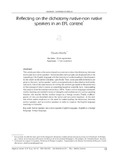| dc.creator | Mariño, Claudia | spa |
| dc.date.accessioned | 2014-10-22T23:29:00Z | spa |
| dc.date.available | 2014-10-22T23:29:00Z | spa |
| dc.date.created | 2011-12-31 | |
| dc.identifier | http://revistas.udem.edu.co/index.php/anagramas/article/view/527 | spa |
| dc.identifier.uri | http://hdl.handle.net/11407/438 | |
| dc.description | This article provides a discussion based on constructs about the dichotomy betweennative and non-native speakers. Several models and examples are displayed about thespreading of the English language with the intention of understanding its developmentin the whole world and in Colombia, specifically. Then, some possible definitions aregiven to the term “native speaker” and its conceptualization is described as both realityand myth. One of the main reasons for writing this article is grounded on the promotionof the concept of what is native as something based on scientific facts, transcendingthe analysis from the common sense (Han, 2004). Topics such as language commandsand its teaching are tackled in terms of strengths and weaknesses of a native-speakingteacher who teaches his/her mother tongue in a foreign country. Finally, students’points of view are described about the native and non-native teachers. At the end,the article makes emphasis on the need for understanding the dichotomy betweennative speakers and non-native speakers in order to improve the English languageteaching in Colombia. | spa |
| dc.format.mimetype | application/pdf | |
| dc.language.iso | spa | |
| dc.publisher | Universidad de Medellín | spa |
| dc.relation | http://revistas.udem.edu.co/index.php/anagramas/article/view/527/476 | spa |
| dc.rights | Copyright (c) 2014 Anagramas | spa |
| dc.rights.uri | http://creativecommons.org/licenses/by-nc-sa/4.0/ | * |
| dc.source | Anagramas; Vol. 10, núm. 19 (2011) | spa |
| dc.source | 2248-4086 | spa |
| dc.source | 1692-2522 | spa |
| dc.subject | Native speaker | spa |
| dc.subject | non-native speaker | spa |
| dc.subject | English languages | spa |
| dc.subject | English as a foreign language;foreign language | spa |
| dc.title | Reflecting on the dichotomy native-non native speakers in an EFL context | spa |
| dc.type | Article | eng |
| dc.relation.references | Braine, G. (Ed.) (1999). Non-native educators in English language teaching. | spa |
| dc.relation.references | Higgins, C. (2003). “Ownership of English in the Outer circle: An alternative to the NS-NNS Dichotomy”. TESOL Quarterly 37, 615-644. | spa |
| dc.relation.references | Braine, G. NNS and Invisible Barriers in ELT. Retrieved on August 1, 2009, from http://nnest.moussu.net/history.html. | spa |
| dc.relation.references | Cook, V.J. (2002). Language teaching methodology and the L2 user perspective. In V.J. Cook (ed.), Portraits of the L2 User, Clevedon: Multilingual Matters. | spa |
| dc.relation.references | Cook, V.J. (ed.) (2003). Effects of the L2 on the L1. Clevedon: Multilingual Matters. | spa |
| dc.relation.references | Cook, V. (2007). The goals of ELT Reproducing native speakers or promoting multi-competence among second language users? Handbook on English Language Teaching. | spa |
| dc.relation.references | Davies, A. (1991). The native speaker in applied linguistics. Edinburgh: Edinburgh University Press. | spa |
| dc.relation.references | Davies. A. (2003). The Native Speaker: Myth and Reality. Clevedon: Multilingual Matters. | spa |
| dc.relation.references | Han, Z. (2004). To Be A Native Speaker means Not To Be A Nonnative Speaker. Second Language Research 20, 2, 166-187. | spa |
| dc.relation.references | Jenkins, J. (2003). World Englishes. A Resource Book for Students. UK: Routledge. | spa |
| dc.relation.references | Higgins, C. (2003). “Ownership of English in the Outer circle: An alternative to the NS-NNS Dichotomy”. TESOL Quarterly 37, 615-644. | spa |
| dc.relation.references | Kachru, B. (1992). The other tongue (2nd Ed). Urbana: University of Illinois Press. | spa |
| dc.relation.references | Lee, J. (2005) The Native Speaker: An Achievable Model? Asian EFL Journal, 7, 9, 2-4. | spa |
| dc.relation.references | Liang, J. (2003, November). Models of NNESTs’ teacher development: Rethinking the NS/NSS dichotomy. NNEST Newsletter, 5(2), 1-5. Retrieved September, 2010, from http://nnest.moussu.net/news/news5 _ 2.pdf | spa |
| dc.relation.references | Ling, C & Braine. G (2007). The Attitudes Of University Students Towards Non-Native Speakers English Teachers In Hong Kong. RELC Journal, 28,3, 257-270. | spa |
| dc.relation.references | McArthur, T. (1987). The English Languages?, English Today, 12, 21-41. | spa |
| dc.relation.references | McArthur, T. (Ed.). (1992). The Oxford companion to the English language. Oxford: OUP. | spa |
| dc.relation.references | Medgyes, P. (1992). Native or non-native: Who’s worth more? ELT Journal, 46, 4, 340-349. | spa |
| dc.relation.references | Medgyes, P. (1994). The non-native teacher. London: Macmillan Publishers. | spa |
| dc.relation.references | Modiano, M. (1999). International English in the global village. English Today, 15, 2, 22-27. | spa |
| dc.relation.references | Paradis, M. (2007). The Cognitive Neuropsychology of Bilingualism. In A.M.B. de Groot and J. Kroll (eds) Tutorial in bilingualism. Psycholinguistic Perspectives (p.p. 331-354). Mahwah, NJ: Lawrence Erlbaum. | spa |
| dc.relation.references | Rampton, M (1990). Displacing the “native speaker”: expertise, affiliation and inheritance. ELT Journal, 44,2,338-343. | spa |
| dc.relation.references | Streven, P. (1980). Teaching English as an International Language: From Practice to Principle. (1st Ed.).Oxford: Pergamon Press. | spa |
| dc.type.version | info:eu-repo/semantics/publishedVersion | |
| dc.type.driver | info:eu-repo/semantics/article | |



